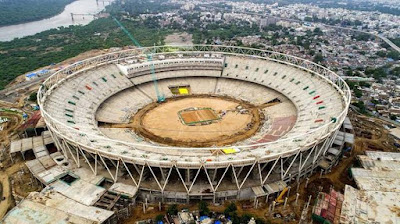The Narendra Modi Stadium is commonly known as the Motera Stadium which is the most premier cricket stadia of India and now going to be the world's largest stadium, which can hold up to 1.1 lakh individuals. The Stadium is located in Ahmedabad, in India, which is under construction which is rebuilt on the same ground as the original stadium.
The old/original Motera Stadium has witnessed some historic moments of Indian Cricket such as:
- Sunil Gavaskar's 10,000th Test Run.
- Kapil Dev's World record 432nd wicket.
- Sachin Tendulkar scored First Double Century in 1999.
The stadium originally had a capacity of 54,000 and when the build was the largest incapacity. Then the record of largest cricket stadium was taken over by Melbourne Cricket Ground (MCG), Australia, which has a capacity of 100,024. The Sardar Patel Stadium/ Motera Stadium is going to snatch this tag from MCG because now it will become the world's largest cricket stadium soon.
Narendra Modi Stadium started its construction in January 2018 and is expected to be completed in March 2020. It will have a capacity of around 110000, which will surpass the capacity of Melbourne Stadium. The stadium will be spread over 63 acres, which would comprise a clubhouse with over 50 rooms, 4 dressing rooms, 76 corporate boxes, and 3 practice grounds for cricketers. There will be an Olympic size swimming pool, an indoor cricket training academy, and a parking area that will accommodate 3000 four-wheelers and up to 10000 two-wheelers. The total project is worth 7 Billion rupees ($102 million). These numbers are truly insane.
This will definitely be the Largest Cricket stadium but will also be in the Top 5 from the Top 10 largest stadiums in the world.
This will definitely be the Largest Cricket stadium but will also be in the Top 5 from the Top 10 largest stadiums in the world.
Walter P Moore is serving as the Structural Engineer and connection designer for the roof of what will be the world's largest cricket stadium. The roof was initially designed to be supported by a trichord compression ring. Walter P Moore proposed a lightweight and flexible tension/compression system which allowed the team to cut costs while simplifying connection and erection procedures. The inner and outer rings support the Teflon Coated woven fiberglass, which is stretched between them supported by spokes, which will allow for movement in time of seismic activity.
Updates:- The stadium was inaugurated with the presence of Prime Minister Modi and President Donald Trump on the 24th of February, 2020 with over 12500 individuals in-house and more.



nice
ReplyDeleteChoosing the best Lahore qalandars team squad 2023 for PSL season eight is not an easy decision especially when you are the defending champions and fans have now much higher expectations from the team to consistently perform on the big stage of PSL. Cricket
ReplyDeleteStadiums feature tiered seating, allowing clear views of the playing field from different angles. Stadium Solutions
ReplyDelete